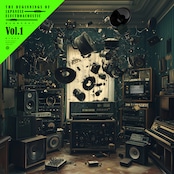

Vinyl 音の始源を求めて① 「電子音楽室」(1955-1968)W/LP
なら 手数料無料で 月々¥2,830から
「音の始源を求めて」 1
電子音楽室 1955-1968
The Beginnings of Japanese Electroacoustic Vol.1
Electronic Music Room 1955-1968
Disc 1
*************************************************
Side A
*************************************************
1. 素数の比系列による正弦波の音楽 黛 敏郎
“Music for Sine Wave by Proportion of Prime Number” Toshiro Mayuzumi 1955
The pitch, intensity, and duration were calculated from the prime ratio, and were produced using sine wave, saw tooth wave, square wave (short wave), and white noise generator. For the idea, the ratio of prime numbers was selected which is based on the partial sound composition with reference to “Study 1” by Stockhausen.
2.7のヴァリエーション 黛 敏郎、諸井 誠 “Variations on Numerical Principle of 7”
Toshiro Mayuzumi & Makoto Moroi 1956
日本における電子音楽黎明期の記念碑的作品。約15分を均等に割り、前半を諸井誠、後半を黛敏郎が作曲しました。全体の構造は「7」という数字に依って支配されており、7つの変奏から成る。第1~第6変奏を諸井誠が、第7変奏を黛敏郎が担当した。諸井のパートでは、総音列技法(トータル・セリアリズム)を導入し、音高、音量、音色、時間といった全ての音楽要素が厳密に構造化されている。使用された音素材は純音、矩形波、鋸歯状波に加え、フィルタ処理を施されたホワイトノイズなどで、当時の最新技術であった電子フェーダーやエコー装置も導入されていた。これらはシュトックハウゼンら西欧前衛の技法を日本で実践・定着させる試みでもあった。一方、黛敏郎による第七変奏では、技法の厳密性に縛られず、電子音を自由な音素材として用いる姿勢が際立つ。黛の音響はより有機的かつ感覚的で、すでに日本独自の電子音楽的感性が萌芽している。本作は構造主義的厳密さと自由な創造性が共存し、日本の電子音楽における技術的基盤と美学的可能性を同時に提示した、先駆的かつ象徴的な作品である。
The tone rows that was gotten the idea from the tone rows method of the twelve- tone technic and that did not include harmonic overtones (49√7n × 70, 70Hz-10015Hz) was used. This tone rows are mainly applied to pure tone, short wave, and saw tooth wave, and white noise is band-cut by the octave filter, and this combination forms a kind of scale. The sequence was also applied to frequency selection configurations, counterpoints, strengths, envelopes, and time elements.
3.ヴァリエテ(第1部分) 諸井 誠 “Variété” Makoto Moroi 1962
この曲は、諸井誠が手がけた最後の“純粋電子音による作品”であり、彼の電子音楽的思考の集大成 といえる。タイトルの通り、本作は五つの断片(フラグメント)から構成されており、それぞれが独立 した音響断面でありながら、全体として緻密な構造をなしている。 本作の最大の特徴は、電子音という素材を即興的に“切り出し”、その断片をセリー的(音列技法) に再編・配置していく構造的手法にある。音高だけでなく、音の持続、音色、音量といったパラメータ も音列化され、いわば“総合音列技法”としてのセリエルが実践されている。個々の断片は、あたかも 記憶の破片や言語の切れ端のように鳴り、従来の旋律やリズムの概念を越えた新たな“音の構築”が 試みられている。
Denying mathematical sound sequence, the Chance Operation method was used, with the appearance rate of pitch, strength, rhythm, and duration being uncertain and randomly distributed using cards, random numbers, etc. It is said that there are limitations to this method’s technique because tapes are edited by hand, with respect to the rhythm, the duration and the level distribution.
*************************************************
Side B
*************************************************
1.ホワイトノイズによるイコン 湯浅譲二
“<ICON> on the source of White Noise” Joji Yuasa 1967
These two works use the original variable frequency filter. Two types of experiments had been done using a tool called a filter to cut out sound from a large volume of white noise.
2.フォノジェーヌ 高橋悠治 “Phonogene” Yuji Takahashi 1961 9’33”
A work for chamber music by electronic sound and 12 players. The two appear to overlap or alternate little by little, but the probabilistic method emphasizes unpredictable results.
3.オリンピック・カンパノロジー 黛 敏郎 “Olympic Campanology” Toshiro Mayuzumi 1964
This work, which was composed based on the sound of the temple bell, was created for the opening ceremony of the 1964 Tokyo Olympics and for the admission of the Emperor. The basic theory is that the element that determines the tone of the temple bell is determined during the transit period of the moment the temple bell is struck.
Disc 2
*************************************************
Side C
*************************************************
1. トランジェント ‘64 松平頼暁“Transient ‘64” Yoriaki Matsudaira 1964
This work was produced using so-called transient sounds, such as the transient oscillation sound that occurs when the 6-channel sine wave oscillator is turned on and the vacuum tube is heated, and the sound when the sine wave cluster is instantaneously applied to a damaged speaker.
2.空、馬そして死 武満 徹 “Sky, Horse and Death” Toru Takemitsu 1958
In 1957 NHK Shuntaro Tanigawa made the music for the radio drama "A Man’s Death" (Billy the Kid’s story) in a music concrete, and the next 58 years, this was called "Sky, Horse and Death" Restructured. Although it is a short work of about 3 minutes and 20 seconds, the “sky” that symbolizes nature, the “horse” that reflects the youthfulness of the hero and the mood of the western United States, and the “death” that expresses a sense of emptiness are beautiful.
*************************************************
Side D
*************************************************
1.マルチ・ピアノのための「カンパノロジー」 黛 敏郎
“Campanology for Multi-Piano Solo” Toshiro Mayuzumi 1966
This work is based on the idea of using a piano instead of a real bell sound to make a campanology with an electronic bell sound. In addition, in order to remove the reverberation sound of the entire instrument from the piano sound, “Multi Strings Pickup” device was developed so that it converts string vibrations directly into electrical signals. It directly modulated the piano sound and played the campanology in real time.
2.電子音のためのインプロヴィゼーション 柴田南雄
“Improvisation for the Electronic Sound” Minao Shibata 1967
This work expresses an unnatural and unstable sound sensation by using tones composed of low frequencies that do not exist physically (sounds of low frequency composition such as 1/2, 1/3, 1/4, etc. in respect to the fundamental wave.)
3.パラレル・ミュージック 一柳 慧 “Parallel Music” Toshi Ichiyanagi 1962
This is a chance-operation work that was made by tuning in and out freely in layers the sounds of musical instruments, environmental noises, human voices, electronic sounds, and other sounds that just come in parallel.
Sound Preview
***************
https://soundcloud.com/oto-no-hajimari/sets/wlp-1955-1968-the-beginnings








